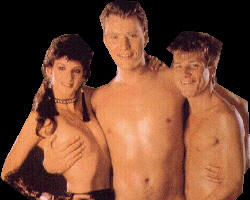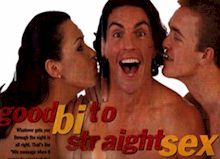 |

 |
|
By Fritz Klein, M.D. Book Review by Janna L. Horowitz The Bisexual Option by Fritz Klein, M.D., Harrington Park Press, an imprint of The Haworth Press, Inc. 1993 Notes: index, bibliography, no illustrations, 215 pages.  Janna L. Horowitz received her M.S.Ed. in counseling psychology from the University of Southern California in 1996. She is currently working on her doctorate in counseling psychology at USC, with specialty areas in college student development, gender, and sexual orientation.
Janna L. Horowitz received her M.S.Ed. in counseling psychology from the University of Southern California in 1996. She is currently working on her doctorate in counseling psychology at USC, with specialty areas in college student development, gender, and sexual orientation.
Abstract: The Bisexual Option is divided into three parts. The first part, What is Bisexuality, addresses The Threat bisexuality poses to heterosexual and homosexual people, the myth of nonexistence, and the either/or stance of society. It also tackles a definition of bisexuality, and the difference between emotional and sexual intimacy and how they related to hetero- and homophobia. The first part concludes with an analysis of the Oedipus Complex and sexuality. The second part, Bisexuality and Health, refers to the psychological health of bisexual people and includes brief case study profiles of both healthy and troubled bisexuals, as defined by Dr. Klein. The third part, The Bisexual in Society, includes sociological findings of a lack of a bisexual community or subculture, the bisexual in history and the arts, and the bisexual future. The book concludes with an Appendix A, The Bisexual as Portrayed in the Arts, and an Appendix B, Bisexual Survey Results as conducted by Dr. Klein from a Bisexual Forum meeting in New York City in 1976-1977.
 Review: In an early review of The Bisexual Option, Eli Coleman wrote that this book is "An outstanding contribution to our understanding of human sexuality." This updated edition of The Bisexual Option remains the most well-written and definitive book on the subject of bisexuality.
Review: In an early review of The Bisexual Option, Eli Coleman wrote that this book is "An outstanding contribution to our understanding of human sexuality." This updated edition of The Bisexual Option remains the most well-written and definitive book on the subject of bisexuality.
Dr. Klein replaces mythology and ignorance with scientific insight and knowledge. This book has had and will continue to have a significant impact on our appreciation of the complexity of the wide range of human sexual expression. In his review, Dr. Coleman most accurately describes the impact of The Bisexual Option, although since its publication more books have been written on bisexuality [i.e., Dual Attraction: Understanding Bisexuality (1994), and RePresenting BiSexualities: Subjects and Cultures of Fluid Desire (1996)] that also impact our understanding of the diversity in bisexuality and human sexuality in general. I chose to review this book because I found it on the reference lists of many psychology research articles that address bisexuality and sexual diversity and thus realized that The Bisexual Option was indeed having a profound impact on psychological conceptualizations of bisexuality.
Klein notes that, Kinsey did not separate psychological reactions from overt experiences [on which the Kinsey rating relies], and concluded that the Kinsey scales were inadequate to meet the needs of understanding what exactly sexual orientation means (p. 15). To define the variety of sexual diversity with regard to bisexuality, Klein offers his Klein Sexual Orientation Grid (KSOG), which is a fantastic conceptualization of sexuality and which I believe is this book's major contribution to understanding sexual diversity. The KSOG lists variables A through G on a vertical axis: A=Sexual Attraction, B=Sexual Behavior, C=Sexual Fantasies, D=Emotional Preference, E=Social Preference, F=Hetero/homosexual Lifestyle, and G=Self Identification. On the horizontal axis are three sections, Past, Present, Ideal. The horizontal axis illustrates Klein's view that sexual orientation can be fluid over time. For variables A through E, the individual chooses from a seven point scale, in which 1=other sex only, 2=other sex mostly, 3=other sex somewhat more, 4=both sexes equally, 5=same sex somewhat more, 6=same sex mostly, 7=same sex only. For variables F and G, the individual chooses from a seven point scale, in which 1=hetero only, 2=hetero mostly, 3=hetero somewhat more, 4=hetero/gay-Lesb. equally, 5=Gay-Lesb. somewhat more, 6=Gay-Lesb. mostly, 7=Gay-Lesb. only. The KSOG expands one's conceptualization of sexuality into a multidimensional framework that serves to deconstruct the labels of homosexual, heterosexual and bisexual as the only three options for sexual orientation. In the KSOG, Klein has tapped into a deeper understanding of sexuality and provided readers with a new and probably more fitting description of their own sexuality. One thing that is puzzling in the KSOG is that, in regard to variables F and G, there is not a Bisexual choice; one must choose with only heterosexual, Gay, and Lesbian labels. Klein states, it was not until recently that people even had the option of thinking of bisexuality as a way of life - one had to be either a heterosexual or a homosexual (p. 17), and no where else does he mention or explain the absence of Bisexual as a Lifestyle or Sexual Identification. Does he mean to say that because bisexuality is only recently recognized that it is not meriting a Lifestyle or Self Identification? Or does he mean to say that because there is not a thriving bisexual community, as he states elsewhere in the book, that it should not be a label choice? Clearly, the KSOG, while otherwise a much appreciated and brilliant conceptualization, has a major drawback in this one very important area. Considering that the book is titled The Bisexual Option, this omission is confusing. The first part of the book concludes with a description of the Oedipus Complex and how it relates to heterosexuals, homosexual, and bisexuals. At this point the reader is struck with Klein's psychoanalytic standpoint that follows throughout the rest of the book. Although the beginning of The Bisexual Option is incredibly valuable, the insertion of the Oedipus Complex is highly psychological and filled with psychoanalytic jargon, which seems less applicable to the average reader. Further, one must buy into the psychoanalytic conception of sexuality to appreciate this section; with no background in psychology I imagine it would be rather difficult to ingest.
 In the second part of the book, Klein offers examples of bisexual peoples' life stories to enhance understanding of the diversity and depth of bisexual lifestyles. He divides these stories into two sections, the Healthy Bisexual and the Troubled Bisexual.
In the second part of the book, Klein offers examples of bisexual peoples' life stories to enhance understanding of the diversity and depth of bisexual lifestyles. He divides these stories into two sections, the Healthy Bisexual and the Troubled Bisexual.
As a psychiatrist, Klein describes clients and acquaintances. The troubled bisexuals are labeled neurotics, another psychoanalytic term. Klein also offers citations and references to Neo-Freudians such as Karen Horney in his explanations of bisexuality. My personal leanings are not toward a psychoanalytic perspective, although I do recognize its merits as a therapeutic framework. Therefore, while I could appreciate some of the theorizing, I did not find it particularly helpful. I did enjoy reading peoples' profiles and personal perspectives of bisexuality in their lives. The third part of this book is a bit disjointed, as it encompasses sociological findings, the bisexual in history and the arts, and the bisexual future. The information in this part is valuable, but the confluence of these sections into one part of the book is questionable. The last chapter, The Bisexual Future, offers ten present day factors that Klein believes will influence bisexuality. They are: AIDS, sex roles and stereotypes, androgyny, friendship and lovers, family, gay lib, the women's movement and feminism, myths, and dilemmas. This section is interesting and provocative. In general, The Bisexual Option is an important work in a world where there is a virtual paucity of books addressing bisexuality. It really does bust open our rigid labels of sexual orientation, and it offers the multidimensional KSOG that expands and enhances our notions of sexuality. For these reasons, I believe it warrants Eli Coleman's comments and stands as a significant contribution to social science literature. Janna L. Horowitz Janna L. Horowitz received her M.S.Ed. in counseling psychology from the University of Southern California in 1996. She is currently working on her doctorate in counseling psychology at USC, with specialty areas in college student development, gender, and sexual orientation. |
 © 1997-99 BEI
© 1997-99 BEI